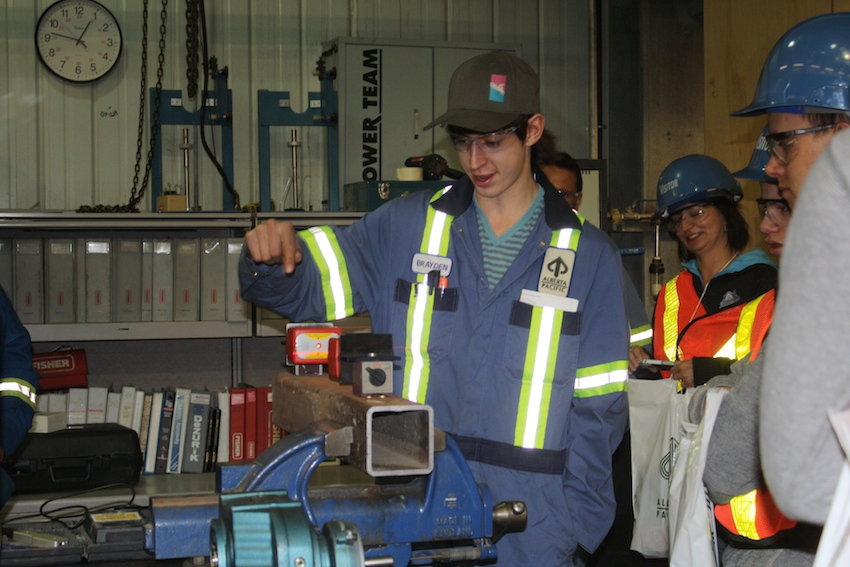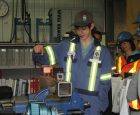
Features
Operations & Management
Workforce
Attracting the next generation
The importance of connecting with your future pulp and paper workers
March 2, 2017 By Alyssa Dalton

Mar. 2, 2017 – The impending skills gap is not a new topic of discussion. Along with proactive succession planning and mentorship between experienced and junior workers is one way to promote knowledge transfer at pulp and paper mills, recruitment — hiring a whole lot of young people — is a significant piece to the puzzle.
The industry’s current employment demographics and technological evolution means we must move quickly to attract and adopt the next generation of workers, but how and where can we find new talent to ensure the industry stays fresh, innovative and competitive?
Connecting employers with potential employees
The Forest Products Association of Canada (FPAC) says forest products companies in Canada recruited 8,000 workers between 2010 to 2012, primarily to replace retiring baby boomers. In an effort to shine a light on the industry, in February 2012, FPAC — with funding from the federal government — launched The Greenest Workforce website (thegreenestworkforce.ca) to help bring more information about the sector to Canadians. While it was successful in providing information on the different types of jobs the sector employs and the reasons to pursue a forest products career, what it was missing was a job board, says Bob Larocque, vice-president of human resources at FPAC. So in June 2016, the Job Match Tool and online labour market information (LMI) were added.
All employers in the Canadian forest products sector can post jobs, use the tool to identify candidates, and access trends and other data to help guide company HR strategies — all for free. Meanwhile, those looking for work gain one-stop access to job openings and can post resumes and search for jobs across the country. The website also features a map of Canada that lets job seekers see how many and what types of jobs are available today, and tailor the job openings to specific provinces and regions.
Larocque says the Job Match Tool has been “very well-received,” garnering a total of 60,000 site visits and about 800 job applications since its introduction. He estimates that 50 per cent of the sector is on the site, and says FPAC is working everyday to get the rest of the industry involved.
“The fact that it’s only for the forest products sector is a very neat, innovative idea,” says Larocque. “There are lots of different job banks in Canada but the forest products sector jobs are getting buried. With [so many] jobs getting posted daily on large [international websites], an employer could post a job today and by tomorrow, it’ll be on page 8.”
The need to hire new workers is wide-spread across the country, he says — no one province is unique in feeling the pressure. “There are more jobs in the bigger provinces, such as Quebec and British Columbia — because they have more mills — but everyone is looking [to hire]. In my mind, it’s based on how many mills are in the province. It’s just relative to the size of the sector in the province.”
The LMI is searchable at the national, provincial and regional levels, as well as by occupation, and lets visitors see what types of jobs the industry will need in the next year or two, or even the next three to five years.
From his perspective, the area that is the hardest to recruit for is the skilled trades, thanks to two main reasons: a knowledge gap and mobility concerns.
“[It’s very common] that someone who is in an apprenticeship or is already working in the skilled trades to not realize that we hire electricians, millwrights and pipefitters in our mills. A lot of people view the forest sector as just forestry and they are unaware that we also hire a lot of other skilled trade professions. I think there are now 55 different careers in the forest products sector [on the website] and the fact that people today still don’t know how many different jobs we hire in this industry is a big surprise to me,” says Larocque. “A second reason is that these jobs are typically in rural areas, so someone doing an apprenticeship at school will likely have to go and finish their studies in a mill, and it’s not going to be in a place like Vancouver, Calgary or Edmonton.”
But potential mill employees aren’t the only visitors targeted on The Greenest Workforce — the website also contains relocation and employment information for spouses and other family members who may also be moving. As well, the Cost Comparison Tool allows job seekers to calculate how much time and money they could be saving by moving from a major city to a smaller community where a mill is located.
A change in the industry
Pulp and paper’s transformation to bio-based products, including cellulose filaments (CF) and cellulose nanocrystals (CNC), is another factor that will change how the industry will attract and hire new talent, he says.
CF is expected to have an immediate impact on Canada’s forest industry due to their capacity to be integrated into other materials and high strength, light weight and flexibility. They can be used as a lightweight strengthening additive to produce lower cost commercial pulps, papers, packaging, tissues and towels.
Meanwhile, FPAC defines CNC as an emerging technology that is light, strong and bio-degradable, and but its “most interesting feature” is its iridescence, which the association says can make it possible to revolutionize many applications including optical films for use in specialty packaging or even to prevent counterfeiting.
“We haven’t quite felt [the effects] yet but we know [they’re] coming,” says Larocque. “This will require some different skillsets. We’re still going to need skilled trades but we are going to need people who understand that type of product. We are just building those mills now but what happens when instead of one biocrude facility, we have five? And instead of one CF plant, we have 10? As the sector transforms, we [need] to make sure we are ready for the change in regard to the skills aspect.”
Recruiting young people through targeted programs
Alberta-Pacific Forest Industries (Al-Pac) offers a variety of different programs specifically directed to hire young workers: the Registered Apprenticeship Program (RAP), a summer student program for children of team members, and a co-op program.
PHOTOS: Alberta-Pacific Forest Industries
Since 2002, the mill has offered the RAP program to provide an apprenticeship placement for four grade 11 and 12 students for a semester, resulting in a total of eight student apprentices a year for various roles: electrician, millwright, machinist, welder, steamfitter/pipefitter, and heavy equipment technician.
“The program gives younger students a feel for what the trades look like and what they’re able to do, so if that’s where they want their path to go, by the time they graduate high school, they’ve already got that background in place before they even get started,” says Stephanie MacKeen, recruitment coordinator at Al-Pac, adding that many students from the RAP program have been hired on once they completed their studies.
Another program targets the sons and daughters of Al-Pac team members. Typically bringing in 30 or more students — depending on the need of the given year — the program matches students with the department that best suits their education studies. For example, if an engineering student would get placed with the engineering department, while an accounting student would join the finance department.
Meanwhile, the co-op program hires students for a four-month contract in the summer.
The mill also manages paid and unpaid co-op programs with Portage College for power engineering students to help them obtain the required steam time hours.
“All these programs are successful because they are tried and true. The nice thing about them is that they cover off so many different areas of study,” says MacKeen. “Since we are located in a small, rural community, these are really vital programs. We want to see the youth remain in the community. I think by giving students chances to come on board and see while we are a pulp mill, we need everybody from IT to engineering to the trades. It offers a great accompaniment of different careers for students to learn about.”
A key to maintaining the success of these programs is through continuous and early promotion, especially for the summer-based ones, says MacKeen. “We attend different career fairs and trade shows to promote what we offer and invite students to come check us out,” she says. “Word of mouth is also a big piece. If we’re looking to do an apprenticeship for a particular trade, we advertise that and through true word-of-mouth, by the next day, we have tons of interest.
I think the opportunities are there, it’s a matter of students knowing how to get at them.”
A community affair
In conjunction with recruiting programs, Al-Pac regularly hosts Career Week, a dedicated week that brings together local high school students, teachers and members of the community to spend a full day at the facility. Guided site tours, business unit information booths, give-aways and door prizes are all part of the fun at Career Week.
“It’s a really neat, hands-on experience for the [entire] community,” says MacKeen. “We have representatives from every [department] meet and greet the students and give them a synopsis of their job functions, so students can get an A to Z view of what we offer. The programs are so important, but it’s one thing to put them in place. You need the support from all teammates within a company to make them possible.
[There is] a real value to young people coming on — the youth are the future.”
This feature was originally published in the Winter 2017 issue of Pulp & Paper Canada.
Print this page



